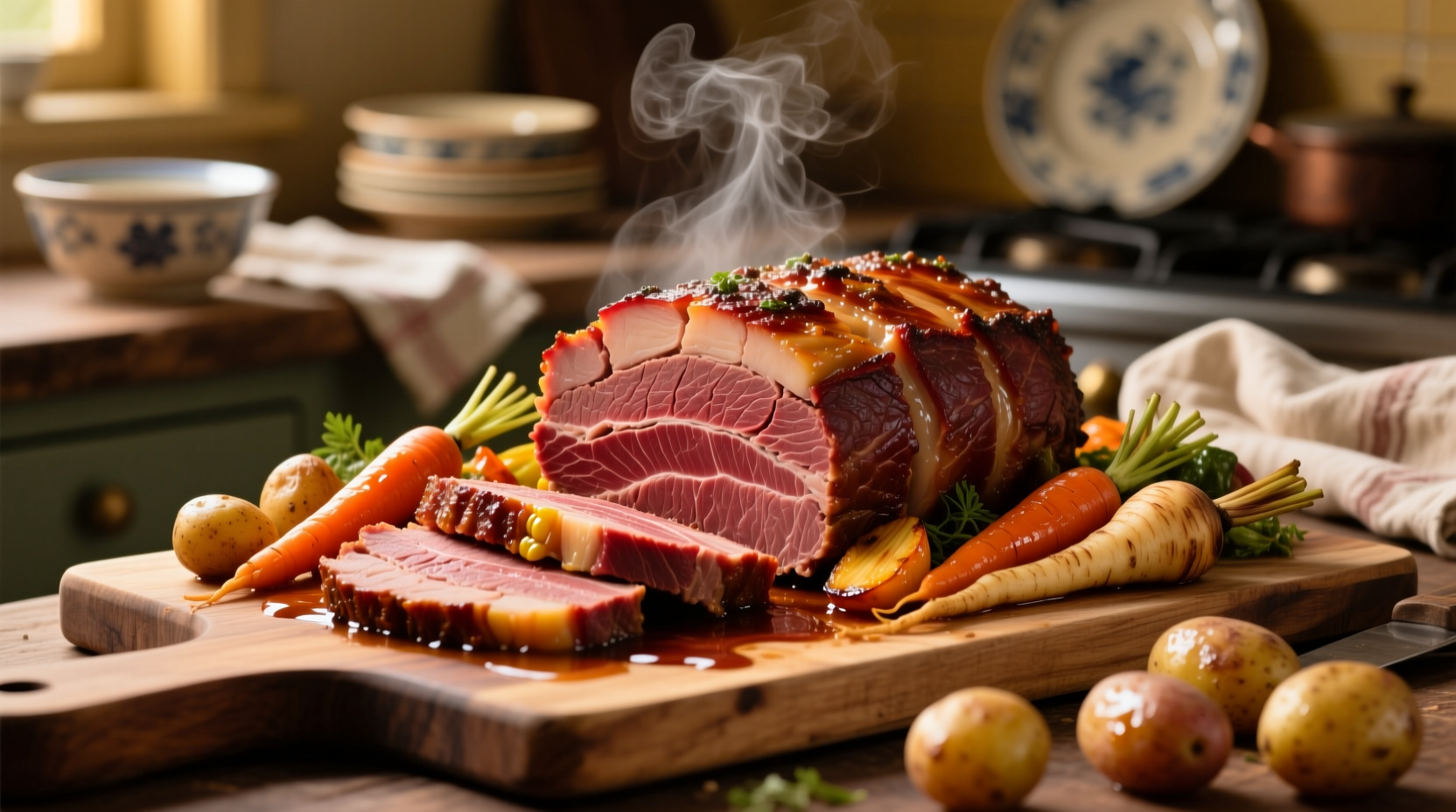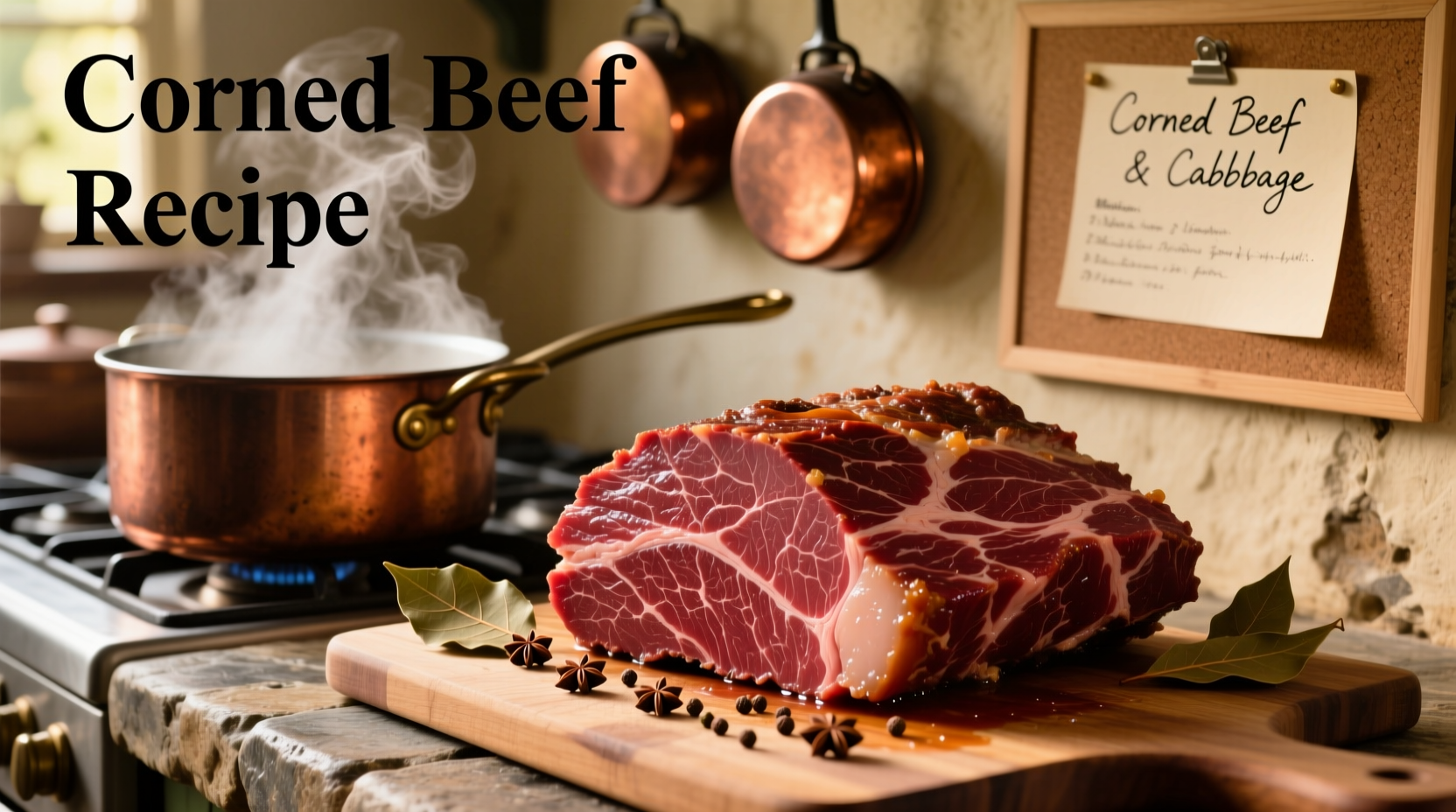Perfectly cooked corned beef requires simmering the cured brisket for 2.5-3.5 hours until it reaches 190-205°F internally. Always rinse the meat first, use cold water start, and maintain a gentle simmer—not a rolling boil—to ensure tender, flavorful results every time.
Nothing beats the rich aroma of properly cooked corned beef filling your kitchen. This beloved dish transforms a tough cut of meat into succulent, fork-tender perfection through careful preparation and precise cooking techniques. Whether you're preparing it for St. Patrick's Day or a comforting weeknight meal, mastering corned beef cooking ensures impressive results that showcase your culinary skills.
What You'll Need Before You Start
Gathering the right ingredients and equipment sets the foundation for success. Corned beef comes pre-cured with its distinctive pink color and spice packet, but you'll need additional components for optimal flavor development.
| Essential Ingredients | Equipment Checklist |
|---|---|
| 3-4 lb corned beef brisket (flat or point cut) | 8-10 quart heavy-bottomed pot or Dutch oven |
| Curing spice packet (included with meat) | Meat thermometer (instant-read or probe) |
| 4-6 cups cold water (enough to cover meat) | Slotted spoon for skimming |
| Optional aromatics: 1 onion, 4 garlic cloves, 2 carrots | Sharp carving knife for slicing |
Preparing Your Corned Beef: The Critical First Steps
Proper preparation significantly impacts your final results. Many home cooks skip these essential steps, leading to overly salty or unevenly cooked meat.
Rinse thoroughly: Despite what some recipes suggest, always rinse your corned beef under cold running water before cooking. This removes excess surface salt that can make the final dish unpleasantly salty. The USDA Food Safety and Inspection Service confirms that rinsing cured meats helps manage sodium levels in the final product while preserving the curing benefits (USDA FSIS).
Consider soaking (optional): For particularly salty cuts, soak the meat in cold water for 30-60 minutes in the refrigerator. Change the water once during soaking. This step is especially valuable if you're sensitive to sodium or using an older cut of meat.
Cooking Methods Compared: Finding Your Perfect Approach
Different cooking techniques yield varying results based on your schedule and equipment. Understanding these differences helps you select the best method for your needs.
| Cooking Method | Time Required | Texture Result | Best For |
|---|---|---|---|
| Stovetop Simmer | 2.5-3.5 hours | Classic tender texture | Traditional preparation, immediate serving |
| Slow Cooker | 8-10 hours on low | Extremely tender, falls apart | Hands-off cooking, meal prep |
| Oven Braising | 3-4 hours at 325°F | Firm yet tender, better crust | Dryer environment cooking, precise temperature control |
Step-by-Step Stovetop Cooking Instructions
The stovetop method remains the gold standard for corned beef preparation, offering the best balance of control and traditional results. Follow these professional techniques for guaranteed success.
- Cold water start: Place the rinsed corned beef in your pot with the fat side down. Add enough cold water to cover the meat completely—approximately 4-6 cups depending on your pot size.
- Add spices: Include the curing spice packet and any additional aromatics. Avoid adding extra salt at this stage.
- Initial boil: Bring the water to a gentle boil over medium-high heat. As it approaches boiling, you'll notice foam rising to the surface.
- Skim carefully: Use a slotted spoon to remove any foam or impurities that rise to the top during the first 10 minutes of cooking. This step creates a cleaner-tasting broth.
- Reduce to simmer: Once foaming subsides, reduce heat to maintain a gentle simmer—small bubbles occasionally breaking the surface, not a rolling boil. Higher temperatures make the meat tough.
- Cover and cook: Partially cover the pot and maintain the simmer for 2.5-3.5 hours. The exact time depends on the size and cut of your brisket.

Precision Timing Guide: When Is It Really Done?
Don't rely solely on cooking time—internal temperature and texture testing provide the most reliable doneness indicators. The American Meat Science Association recommends cooking corned beef to 190-205°F for optimal tenderness (AMSA).
Create a visual timeline for your specific cut:
- 0-60 minutes: Meat firms up as proteins begin to contract
- 60-120 minutes: Collagen starts breaking down, meat begins to soften
- 120-180 minutes: Significant tenderness develops as connective tissues melt
- 180+ minutes: Optimal tenderness range for most cuts
Test for doneness by inserting a fork at 180 minutes. The meat should offer little resistance. If it feels tough, continue cooking in 15-minute increments until fork-tender.
The Critical Resting Phase: Why You Can't Skip This
Removing the corned beef from heat isn't the finish line. Proper resting allows the meat fibers to reabsorb juices, preventing dryness when slicing.
Transfer the cooked corned beef to a cutting board and tent loosely with foil. Allow it to rest for 15-20 minutes. During this time, the internal temperature will continue to rise 5-10 degrees (carryover cooking), and the meat structure will stabilize for cleaner slicing.
Slicing Technique: The Professional's Secret
How you slice dramatically affects texture and presentation. Always slice against the grain—perpendicular to the muscle fibers—to shorten them and create more tender bites.
Identify the direction of the grain by looking for the parallel lines of muscle fiber running through the cooked meat. Position your knife at a 90-degree angle to these lines and cut 1/4-inch thick slices. Thinner slices work better for sandwiches, while thicker slices suit plated entrees.
Serving Suggestions That Elevate Your Dish
Traditional pairings enhance corned beef's rich flavor profile while modern variations offer exciting twists for adventurous palates.
Classic combinations: Serve with boiled potatoes, cabbage, and carrots cooked in the same flavorful broth. The vegetables absorb the meat's rich flavors while contributing their own sweetness to balance the saltiness.
Modern variations: Try corned beef hash with crispy potatoes and fried eggs for brunch, or slice thinly for Reuben sandwiches with Swiss cheese, sauerkraut, and Russian dressing on rye bread.
Troubleshooting Common Corned Beef Problems
Even experienced cooks encounter issues. Understanding these common problems helps you rescue your meal and improve future attempts.
- Too salty: Rinse more thoroughly next time and consider a 30-minute soak. For the current batch, serve with unsalted vegetables or potatoes to balance the flavor.
- Tough texture: Continue cooking in 15-minute increments until fork-tender. This indicates insufficient time for connective tissue breakdown.
- Dry results: You likely boiled instead of simmered, or didn't rest the meat properly before slicing.
- Cloudy broth: Not skimming the initial foam properly. While this doesn't affect flavor, it impacts presentation.
Storage and Creative Leftover Ideas
Proper storage maintains quality, while creative repurposing transforms leftovers into new meals.
Store cooled corned beef in airtight containers with some cooking liquid for up to 4 days in the refrigerator, or freeze for up to 3 months. When reheating, use gentle methods like simmering in broth rather than microwaving to preserve texture.
Transform leftovers into corned beef and cabbage soup, breakfast hash, or add diced pieces to omelets. Thinly sliced leftovers make excellent sandwiches throughout the week.











 浙公网安备
33010002000092号
浙公网安备
33010002000092号 浙B2-20120091-4
浙B2-20120091-4